Exploratory Quantitative Techniques in Understanding Society
VerifiedAdded on 2019/09/21
|6
|2456
|131
Report
AI Summary
This assignment discusses various research approaches, methodologies, and strategies used to study societal phenomena. The positivist approach views society as shaping an individual's stand, while interpretivists emphasize humanistic subjective strategies. The report uses both inductive and deductive approaches, with the former providing structure for exploratory science and the latter utilizing logical procedures for achieving a specific result. Archival research was also employed to gather information on past studies related to the research objectives and questions. Additionally, surveys, interviews, questionnaires, case studies, observational trials, and Delphi method were used in this study. The report highlights the importance of considering different approaches and methodologies in understanding complex social phenomena.
Contribute Materials
Your contribution can guide someone’s learning journey. Share your
documents today.
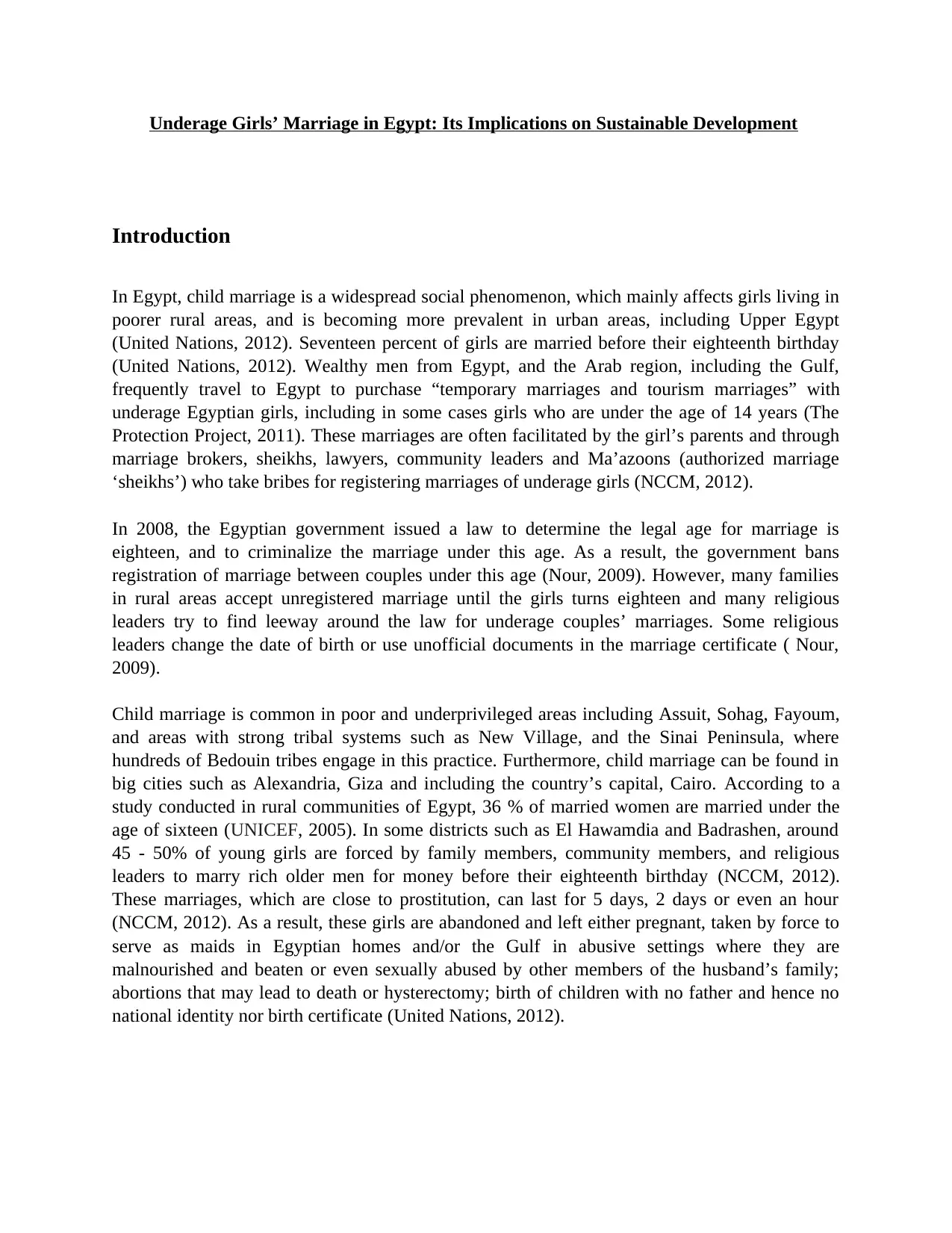
Underage Girls’ Marriage in Egypt: Its Implications on Sustainable Development
Introduction
In Egypt, child marriage is a widespread social phenomenon, which mainly affects girls living in
poorer rural areas, and is becoming more prevalent in urban areas, including Upper Egypt
(United Nations, 2012). Seventeen percent of girls are married before their eighteenth birthday
(United Nations, 2012). Wealthy men from Egypt, and the Arab region, including the Gulf,
frequently travel to Egypt to purchase “temporary marriages and tourism marriages” with
underage Egyptian girls, including in some cases girls who are under the age of 14 years (The
Protection Project, 2011). These marriages are often facilitated by the girl’s parents and through
marriage brokers, sheikhs, lawyers, community leaders and Ma’azoons (authorized marriage
‘sheikhs’) who take bribes for registering marriages of underage girls (NCCM, 2012).
In 2008, the Egyptian government issued a law to determine the legal age for marriage is
eighteen, and to criminalize the marriage under this age. As a result, the government bans
registration of marriage between couples under this age (Nour, 2009). However, many families
in rural areas accept unregistered marriage until the girls turns eighteen and many religious
leaders try to find leeway around the law for underage couples’ marriages. Some religious
leaders change the date of birth or use unofficial documents in the marriage certificate ( Nour,
2009).
Child marriage is common in poor and underprivileged areas including Assuit, Sohag, Fayoum,
and areas with strong tribal systems such as New Village, and the Sinai Peninsula, where
hundreds of Bedouin tribes engage in this practice. Furthermore, child marriage can be found in
big cities such as Alexandria, Giza and including the country’s capital, Cairo. According to a
study conducted in rural communities of Egypt, 36 % of married women are married under the
age of sixteen (UNICEF, 2005). In some districts such as El Hawamdia and Badrashen, around
45 - 50% of young girls are forced by family members, community members, and religious
leaders to marry rich older men for money before their eighteenth birthday (NCCM, 2012).
These marriages, which are close to prostitution, can last for 5 days, 2 days or even an hour
(NCCM, 2012). As a result, these girls are abandoned and left either pregnant, taken by force to
serve as maids in Egyptian homes and/or the Gulf in abusive settings where they are
malnourished and beaten or even sexually abused by other members of the husband’s family;
abortions that may lead to death or hysterectomy; birth of children with no father and hence no
national identity nor birth certificate (United Nations, 2012).
Introduction
In Egypt, child marriage is a widespread social phenomenon, which mainly affects girls living in
poorer rural areas, and is becoming more prevalent in urban areas, including Upper Egypt
(United Nations, 2012). Seventeen percent of girls are married before their eighteenth birthday
(United Nations, 2012). Wealthy men from Egypt, and the Arab region, including the Gulf,
frequently travel to Egypt to purchase “temporary marriages and tourism marriages” with
underage Egyptian girls, including in some cases girls who are under the age of 14 years (The
Protection Project, 2011). These marriages are often facilitated by the girl’s parents and through
marriage brokers, sheikhs, lawyers, community leaders and Ma’azoons (authorized marriage
‘sheikhs’) who take bribes for registering marriages of underage girls (NCCM, 2012).
In 2008, the Egyptian government issued a law to determine the legal age for marriage is
eighteen, and to criminalize the marriage under this age. As a result, the government bans
registration of marriage between couples under this age (Nour, 2009). However, many families
in rural areas accept unregistered marriage until the girls turns eighteen and many religious
leaders try to find leeway around the law for underage couples’ marriages. Some religious
leaders change the date of birth or use unofficial documents in the marriage certificate ( Nour,
2009).
Child marriage is common in poor and underprivileged areas including Assuit, Sohag, Fayoum,
and areas with strong tribal systems such as New Village, and the Sinai Peninsula, where
hundreds of Bedouin tribes engage in this practice. Furthermore, child marriage can be found in
big cities such as Alexandria, Giza and including the country’s capital, Cairo. According to a
study conducted in rural communities of Egypt, 36 % of married women are married under the
age of sixteen (UNICEF, 2005). In some districts such as El Hawamdia and Badrashen, around
45 - 50% of young girls are forced by family members, community members, and religious
leaders to marry rich older men for money before their eighteenth birthday (NCCM, 2012).
These marriages, which are close to prostitution, can last for 5 days, 2 days or even an hour
(NCCM, 2012). As a result, these girls are abandoned and left either pregnant, taken by force to
serve as maids in Egyptian homes and/or the Gulf in abusive settings where they are
malnourished and beaten or even sexually abused by other members of the husband’s family;
abortions that may lead to death or hysterectomy; birth of children with no father and hence no
national identity nor birth certificate (United Nations, 2012).
Secure Best Marks with AI Grader
Need help grading? Try our AI Grader for instant feedback on your assignments.
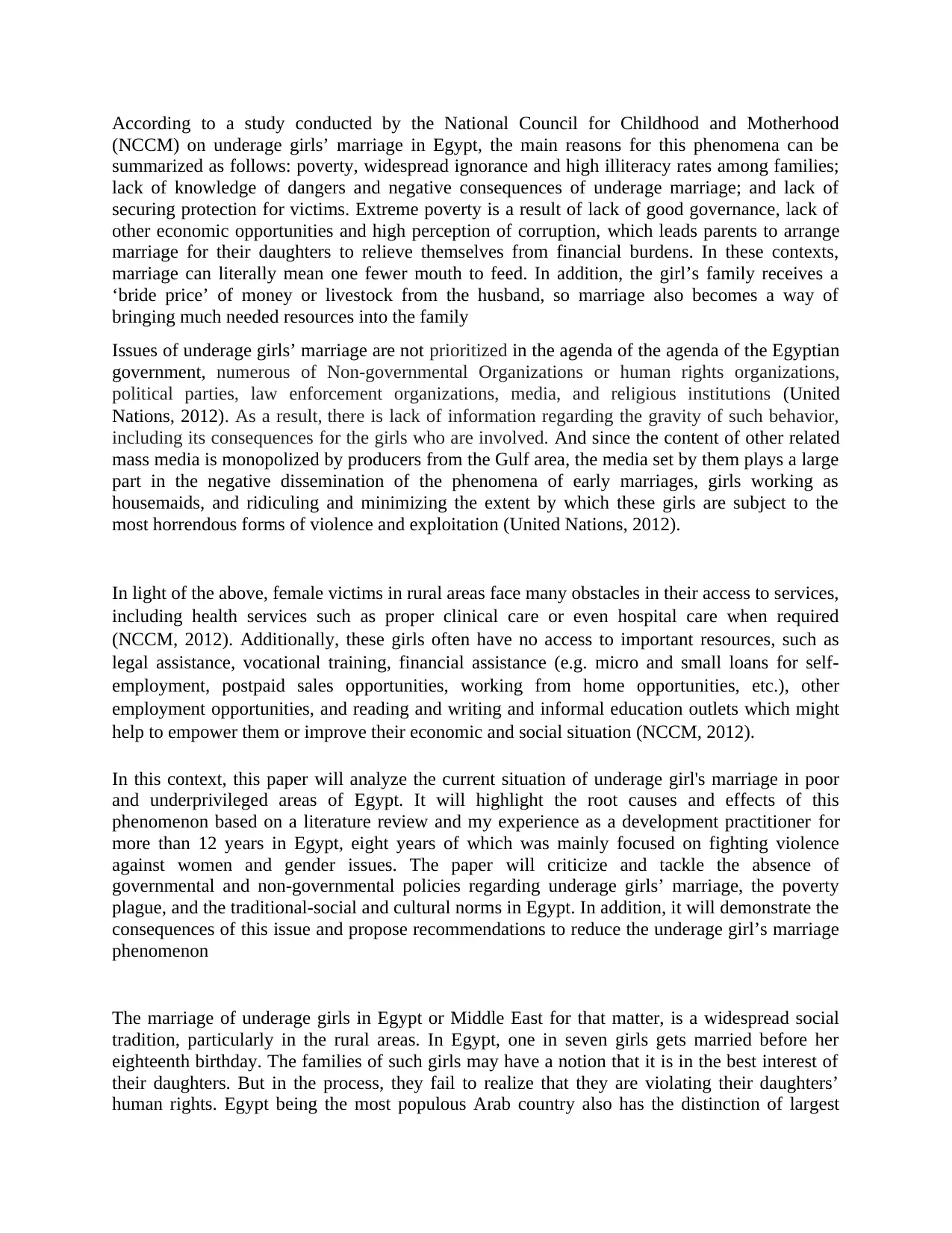
According to a study conducted by the National Council for Childhood and Motherhood
(NCCM) on underage girls’ marriage in Egypt, the main reasons for this phenomena can be
summarized as follows: poverty, widespread ignorance and high illiteracy rates among families;
lack of knowledge of dangers and negative consequences of underage marriage; and lack of
securing protection for victims. Extreme poverty is a result of lack of good governance, lack of
other economic opportunities and high perception of corruption, which leads parents to arrange
marriage for their daughters to relieve themselves from financial burdens. In these contexts,
marriage can literally mean one fewer mouth to feed. In addition, the girl’s family receives a
‘bride price’ of money or livestock from the husband, so marriage also becomes a way of
bringing much needed resources into the family
Issues of underage girls’ marriage are not prioritized in the agenda of the agenda of the Egyptian
government, numerous of Non-governmental Organizations or human rights organizations,
political parties, law enforcement organizations, media, and religious institutions (United
Nations, 2012). As a result, there is lack of information regarding the gravity of such behavior,
including its consequences for the girls who are involved. And since the content of other related
mass media is monopolized by producers from the Gulf area, the media set by them plays a large
part in the negative dissemination of the phenomena of early marriages, girls working as
housemaids, and ridiculing and minimizing the extent by which these girls are subject to the
most horrendous forms of violence and exploitation (United Nations, 2012).
In light of the above, female victims in rural areas face many obstacles in their access to services,
including health services such as proper clinical care or even hospital care when required
(NCCM, 2012). Additionally, these girls often have no access to important resources, such as
legal assistance, vocational training, financial assistance (e.g. micro and small loans for self-
employment, postpaid sales opportunities, working from home opportunities, etc.), other
employment opportunities, and reading and writing and informal education outlets which might
help to empower them or improve their economic and social situation (NCCM, 2012).
In this context, this paper will analyze the current situation of underage girl's marriage in poor
and underprivileged areas of Egypt. It will highlight the root causes and effects of this
phenomenon based on a literature review and my experience as a development practitioner for
more than 12 years in Egypt, eight years of which was mainly focused on fighting violence
against women and gender issues. The paper will criticize and tackle the absence of
governmental and non-governmental policies regarding underage girls’ marriage, the poverty
plague, and the traditional-social and cultural norms in Egypt. In addition, it will demonstrate the
consequences of this issue and propose recommendations to reduce the underage girl’s marriage
phenomenon
The marriage of underage girls in Egypt or Middle East for that matter, is a widespread social
tradition, particularly in the rural areas. In Egypt, one in seven girls gets married before her
eighteenth birthday. The families of such girls may have a notion that it is in the best interest of
their daughters. But in the process, they fail to realize that they are violating their daughters’
human rights. Egypt being the most populous Arab country also has the distinction of largest
(NCCM) on underage girls’ marriage in Egypt, the main reasons for this phenomena can be
summarized as follows: poverty, widespread ignorance and high illiteracy rates among families;
lack of knowledge of dangers and negative consequences of underage marriage; and lack of
securing protection for victims. Extreme poverty is a result of lack of good governance, lack of
other economic opportunities and high perception of corruption, which leads parents to arrange
marriage for their daughters to relieve themselves from financial burdens. In these contexts,
marriage can literally mean one fewer mouth to feed. In addition, the girl’s family receives a
‘bride price’ of money or livestock from the husband, so marriage also becomes a way of
bringing much needed resources into the family
Issues of underage girls’ marriage are not prioritized in the agenda of the agenda of the Egyptian
government, numerous of Non-governmental Organizations or human rights organizations,
political parties, law enforcement organizations, media, and religious institutions (United
Nations, 2012). As a result, there is lack of information regarding the gravity of such behavior,
including its consequences for the girls who are involved. And since the content of other related
mass media is monopolized by producers from the Gulf area, the media set by them plays a large
part in the negative dissemination of the phenomena of early marriages, girls working as
housemaids, and ridiculing and minimizing the extent by which these girls are subject to the
most horrendous forms of violence and exploitation (United Nations, 2012).
In light of the above, female victims in rural areas face many obstacles in their access to services,
including health services such as proper clinical care or even hospital care when required
(NCCM, 2012). Additionally, these girls often have no access to important resources, such as
legal assistance, vocational training, financial assistance (e.g. micro and small loans for self-
employment, postpaid sales opportunities, working from home opportunities, etc.), other
employment opportunities, and reading and writing and informal education outlets which might
help to empower them or improve their economic and social situation (NCCM, 2012).
In this context, this paper will analyze the current situation of underage girl's marriage in poor
and underprivileged areas of Egypt. It will highlight the root causes and effects of this
phenomenon based on a literature review and my experience as a development practitioner for
more than 12 years in Egypt, eight years of which was mainly focused on fighting violence
against women and gender issues. The paper will criticize and tackle the absence of
governmental and non-governmental policies regarding underage girls’ marriage, the poverty
plague, and the traditional-social and cultural norms in Egypt. In addition, it will demonstrate the
consequences of this issue and propose recommendations to reduce the underage girl’s marriage
phenomenon
The marriage of underage girls in Egypt or Middle East for that matter, is a widespread social
tradition, particularly in the rural areas. In Egypt, one in seven girls gets married before her
eighteenth birthday. The families of such girls may have a notion that it is in the best interest of
their daughters. But in the process, they fail to realize that they are violating their daughters’
human rights. Egypt being the most populous Arab country also has the distinction of largest
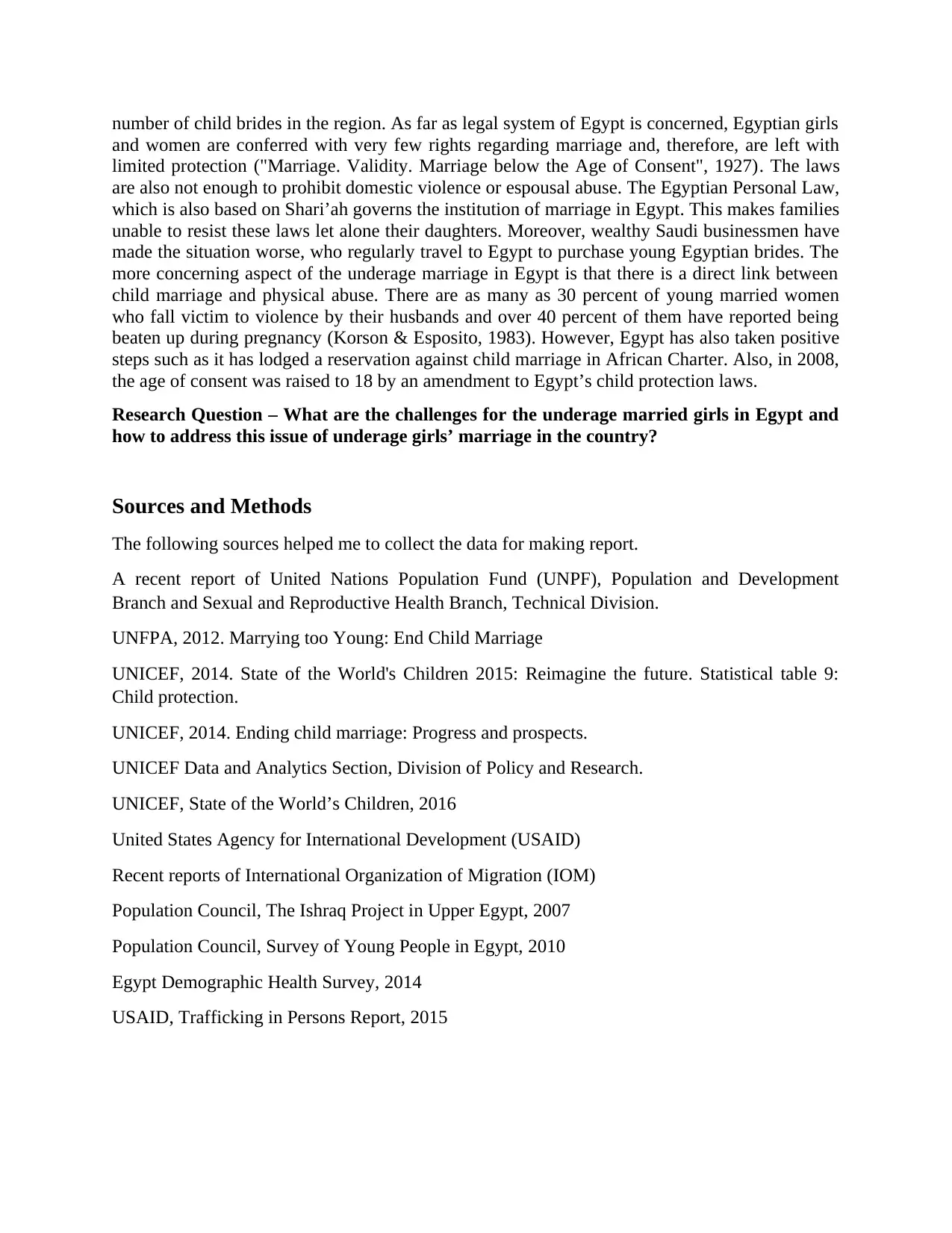
number of child brides in the region. As far as legal system of Egypt is concerned, Egyptian girls
and women are conferred with very few rights regarding marriage and, therefore, are left with
limited protection ("Marriage. Validity. Marriage below the Age of Consent", 1927). The laws
are also not enough to prohibit domestic violence or espousal abuse. The Egyptian Personal Law,
which is also based on Shari’ah governs the institution of marriage in Egypt. This makes families
unable to resist these laws let alone their daughters. Moreover, wealthy Saudi businessmen have
made the situation worse, who regularly travel to Egypt to purchase young Egyptian brides. The
more concerning aspect of the underage marriage in Egypt is that there is a direct link between
child marriage and physical abuse. There are as many as 30 percent of young married women
who fall victim to violence by their husbands and over 40 percent of them have reported being
beaten up during pregnancy (Korson & Esposito, 1983). However, Egypt has also taken positive
steps such as it has lodged a reservation against child marriage in African Charter. Also, in 2008,
the age of consent was raised to 18 by an amendment to Egypt’s child protection laws.
Research Question – What are the challenges for the underage married girls in Egypt and
how to address this issue of underage girls’ marriage in the country?
Sources and Methods
The following sources helped me to collect the data for making report.
A recent report of United Nations Population Fund (UNPF), Population and Development
Branch and Sexual and Reproductive Health Branch, Technical Division.
UNFPA, 2012. Marrying too Young: End Child Marriage
UNICEF, 2014. State of the World's Children 2015: Reimagine the future. Statistical table 9:
Child protection.
UNICEF, 2014. Ending child marriage: Progress and prospects.
UNICEF Data and Analytics Section, Division of Policy and Research.
UNICEF, State of the World’s Children, 2016
United States Agency for International Development (USAID)
Recent reports of International Organization of Migration (IOM)
Population Council, The Ishraq Project in Upper Egypt, 2007
Population Council, Survey of Young People in Egypt, 2010
Egypt Demographic Health Survey, 2014
USAID, Trafficking in Persons Report, 2015
and women are conferred with very few rights regarding marriage and, therefore, are left with
limited protection ("Marriage. Validity. Marriage below the Age of Consent", 1927). The laws
are also not enough to prohibit domestic violence or espousal abuse. The Egyptian Personal Law,
which is also based on Shari’ah governs the institution of marriage in Egypt. This makes families
unable to resist these laws let alone their daughters. Moreover, wealthy Saudi businessmen have
made the situation worse, who regularly travel to Egypt to purchase young Egyptian brides. The
more concerning aspect of the underage marriage in Egypt is that there is a direct link between
child marriage and physical abuse. There are as many as 30 percent of young married women
who fall victim to violence by their husbands and over 40 percent of them have reported being
beaten up during pregnancy (Korson & Esposito, 1983). However, Egypt has also taken positive
steps such as it has lodged a reservation against child marriage in African Charter. Also, in 2008,
the age of consent was raised to 18 by an amendment to Egypt’s child protection laws.
Research Question – What are the challenges for the underage married girls in Egypt and
how to address this issue of underage girls’ marriage in the country?
Sources and Methods
The following sources helped me to collect the data for making report.
A recent report of United Nations Population Fund (UNPF), Population and Development
Branch and Sexual and Reproductive Health Branch, Technical Division.
UNFPA, 2012. Marrying too Young: End Child Marriage
UNICEF, 2014. State of the World's Children 2015: Reimagine the future. Statistical table 9:
Child protection.
UNICEF, 2014. Ending child marriage: Progress and prospects.
UNICEF Data and Analytics Section, Division of Policy and Research.
UNICEF, State of the World’s Children, 2016
United States Agency for International Development (USAID)
Recent reports of International Organization of Migration (IOM)
Population Council, The Ishraq Project in Upper Egypt, 2007
Population Council, Survey of Young People in Egypt, 2010
Egypt Demographic Health Survey, 2014
USAID, Trafficking in Persons Report, 2015
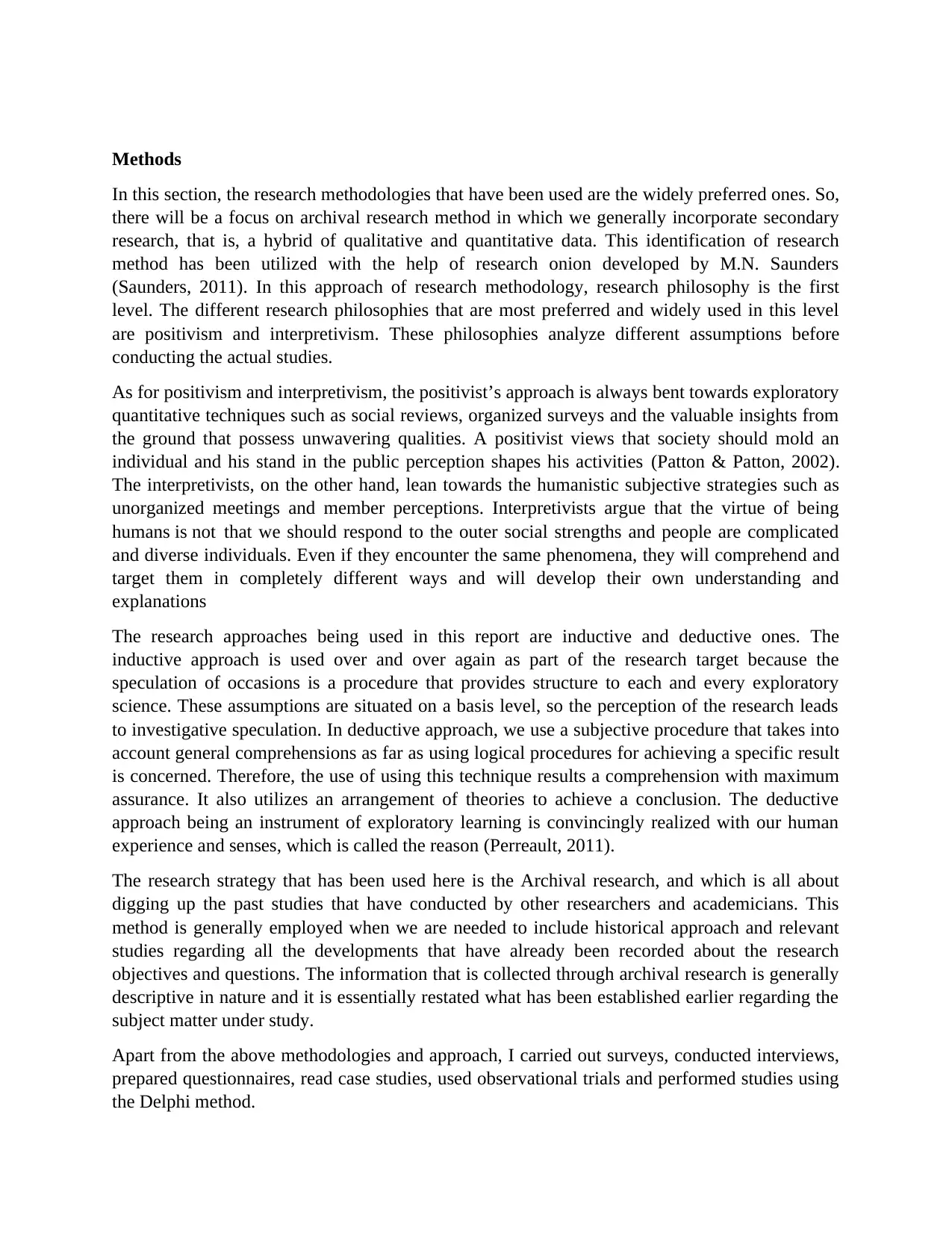
Methods
In this section, the research methodologies that have been used are the widely preferred ones. So,
there will be a focus on archival research method in which we generally incorporate secondary
research, that is, a hybrid of qualitative and quantitative data. This identification of research
method has been utilized with the help of research onion developed by M.N. Saunders
(Saunders, 2011). In this approach of research methodology, research philosophy is the first
level. The different research philosophies that are most preferred and widely used in this level
are positivism and interpretivism. These philosophies analyze different assumptions before
conducting the actual studies.
As for positivism and interpretivism, the positivist’s approach is always bent towards exploratory
quantitative techniques such as social reviews, organized surveys and the valuable insights from
the ground that possess unwavering qualities. A positivist views that society should mold an
individual and his stand in the public perception shapes his activities (Patton & Patton, 2002).
The interpretivists, on the other hand, lean towards the humanistic subjective strategies such as
unorganized meetings and member perceptions. Interpretivists argue that the virtue of being
humans is not that we should respond to the outer social strengths and people are complicated
and diverse individuals. Even if they encounter the same phenomena, they will comprehend and
target them in completely different ways and will develop their own understanding and
explanations
The research approaches being used in this report are inductive and deductive ones. The
inductive approach is used over and over again as part of the research target because the
speculation of occasions is a procedure that provides structure to each and every exploratory
science. These assumptions are situated on a basis level, so the perception of the research leads
to investigative speculation. In deductive approach, we use a subjective procedure that takes into
account general comprehensions as far as using logical procedures for achieving a specific result
is concerned. Therefore, the use of using this technique results a comprehension with maximum
assurance. It also utilizes an arrangement of theories to achieve a conclusion. The deductive
approach being an instrument of exploratory learning is convincingly realized with our human
experience and senses, which is called the reason (Perreault, 2011).
The research strategy that has been used here is the Archival research, and which is all about
digging up the past studies that have conducted by other researchers and academicians. This
method is generally employed when we are needed to include historical approach and relevant
studies regarding all the developments that have already been recorded about the research
objectives and questions. The information that is collected through archival research is generally
descriptive in nature and it is essentially restated what has been established earlier regarding the
subject matter under study.
Apart from the above methodologies and approach, I carried out surveys, conducted interviews,
prepared questionnaires, read case studies, used observational trials and performed studies using
the Delphi method.
In this section, the research methodologies that have been used are the widely preferred ones. So,
there will be a focus on archival research method in which we generally incorporate secondary
research, that is, a hybrid of qualitative and quantitative data. This identification of research
method has been utilized with the help of research onion developed by M.N. Saunders
(Saunders, 2011). In this approach of research methodology, research philosophy is the first
level. The different research philosophies that are most preferred and widely used in this level
are positivism and interpretivism. These philosophies analyze different assumptions before
conducting the actual studies.
As for positivism and interpretivism, the positivist’s approach is always bent towards exploratory
quantitative techniques such as social reviews, organized surveys and the valuable insights from
the ground that possess unwavering qualities. A positivist views that society should mold an
individual and his stand in the public perception shapes his activities (Patton & Patton, 2002).
The interpretivists, on the other hand, lean towards the humanistic subjective strategies such as
unorganized meetings and member perceptions. Interpretivists argue that the virtue of being
humans is not that we should respond to the outer social strengths and people are complicated
and diverse individuals. Even if they encounter the same phenomena, they will comprehend and
target them in completely different ways and will develop their own understanding and
explanations
The research approaches being used in this report are inductive and deductive ones. The
inductive approach is used over and over again as part of the research target because the
speculation of occasions is a procedure that provides structure to each and every exploratory
science. These assumptions are situated on a basis level, so the perception of the research leads
to investigative speculation. In deductive approach, we use a subjective procedure that takes into
account general comprehensions as far as using logical procedures for achieving a specific result
is concerned. Therefore, the use of using this technique results a comprehension with maximum
assurance. It also utilizes an arrangement of theories to achieve a conclusion. The deductive
approach being an instrument of exploratory learning is convincingly realized with our human
experience and senses, which is called the reason (Perreault, 2011).
The research strategy that has been used here is the Archival research, and which is all about
digging up the past studies that have conducted by other researchers and academicians. This
method is generally employed when we are needed to include historical approach and relevant
studies regarding all the developments that have already been recorded about the research
objectives and questions. The information that is collected through archival research is generally
descriptive in nature and it is essentially restated what has been established earlier regarding the
subject matter under study.
Apart from the above methodologies and approach, I carried out surveys, conducted interviews,
prepared questionnaires, read case studies, used observational trials and performed studies using
the Delphi method.
Paraphrase This Document
Need a fresh take? Get an instant paraphrase of this document with our AI Paraphraser
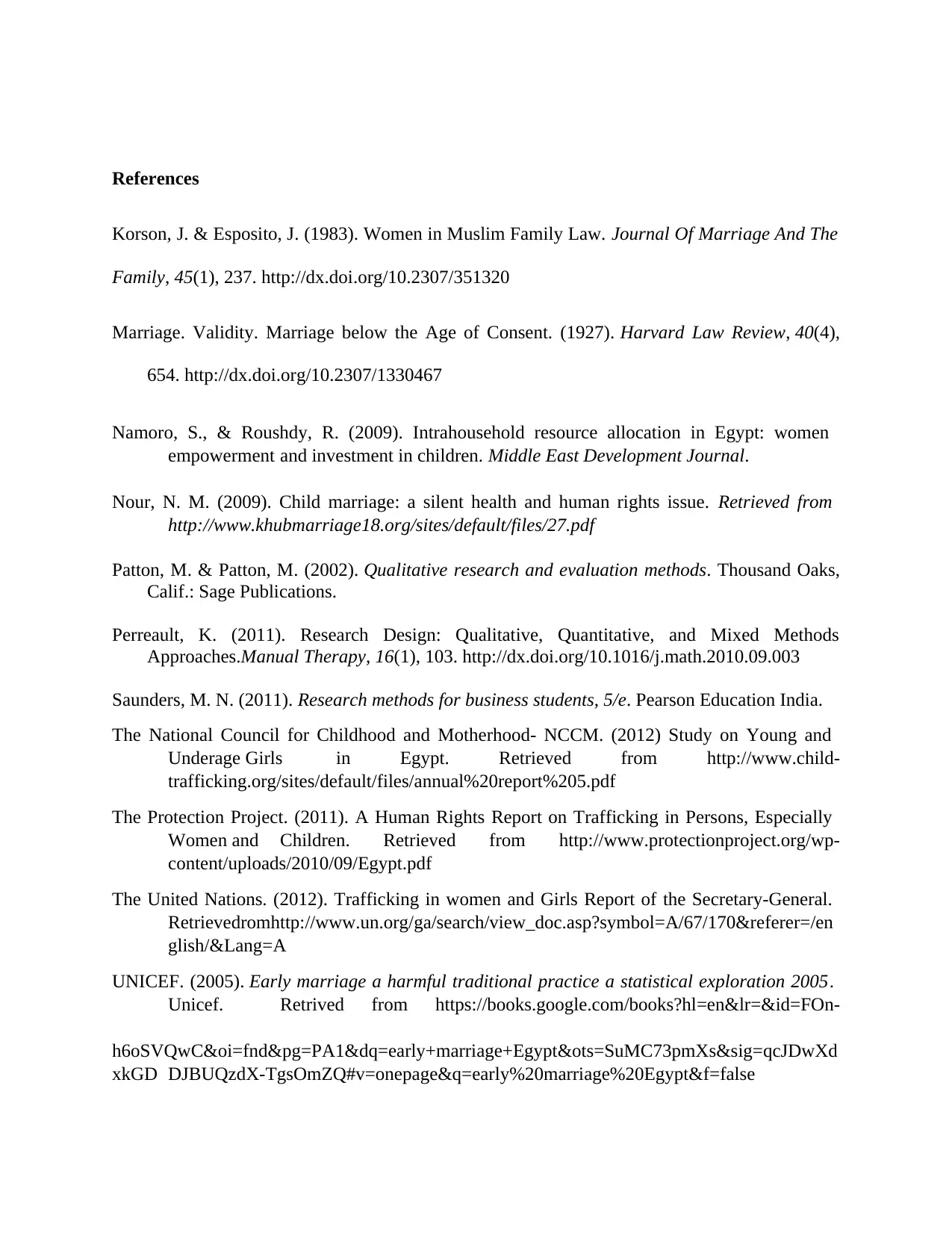
References
Korson, J. & Esposito, J. (1983). Women in Muslim Family Law. Journal Of Marriage And The
Family, 45(1), 237. http://dx.doi.org/10.2307/351320
Marriage. Validity. Marriage below the Age of Consent. (1927). Harvard Law Review, 40(4),
654. http://dx.doi.org/10.2307/1330467
Namoro, S., & Roushdy, R. (2009). Intrahousehold resource allocation in Egypt: women
empowerment and investment in children. Middle East Development Journal.
Nour, N. M. (2009). Child marriage: a silent health and human rights issue. Retrieved from
http://www.khubmarriage18.org/sites/default/files/27.pdf
Patton, M. & Patton, M. (2002). Qualitative research and evaluation methods. Thousand Oaks,
Calif.: Sage Publications.
Perreault, K. (2011). Research Design: Qualitative, Quantitative, and Mixed Methods
Approaches.Manual Therapy, 16(1), 103. http://dx.doi.org/10.1016/j.math.2010.09.003
Saunders, M. N. (2011). Research methods for business students, 5/e. Pearson Education India.
The National Council for Childhood and Motherhood- NCCM. (2012) Study on Young and
Underage Girls in Egypt. Retrieved from http://www.child-
trafficking.org/sites/default/files/annual%20report%205.pdf
The Protection Project. (2011). A Human Rights Report on Trafficking in Persons, Especially
Women and Children. Retrieved from http://www.protectionproject.org/wp-
content/uploads/2010/09/Egypt.pdf
The United Nations. (2012). Trafficking in women and Girls Report of the Secretary-General.
Retrievedromhttp://www.un.org/ga/search/view_doc.asp?symbol=A/67/170&referer=/en
glish/&Lang=A
UNICEF. (2005). Early marriage a harmful traditional practice a statistical exploration 2005.
Unicef. Retrived from https://books.google.com/books?hl=en&lr=&id=FOn-
h6oSVQwC&oi=fnd&pg=PA1&dq=early+marriage+Egypt&ots=SuMC73pmXs&sig=qcJDwXd
xkGD DJBUQzdX-TgsOmZQ#v=onepage&q=early%20marriage%20Egypt&f=false
Korson, J. & Esposito, J. (1983). Women in Muslim Family Law. Journal Of Marriage And The
Family, 45(1), 237. http://dx.doi.org/10.2307/351320
Marriage. Validity. Marriage below the Age of Consent. (1927). Harvard Law Review, 40(4),
654. http://dx.doi.org/10.2307/1330467
Namoro, S., & Roushdy, R. (2009). Intrahousehold resource allocation in Egypt: women
empowerment and investment in children. Middle East Development Journal.
Nour, N. M. (2009). Child marriage: a silent health and human rights issue. Retrieved from
http://www.khubmarriage18.org/sites/default/files/27.pdf
Patton, M. & Patton, M. (2002). Qualitative research and evaluation methods. Thousand Oaks,
Calif.: Sage Publications.
Perreault, K. (2011). Research Design: Qualitative, Quantitative, and Mixed Methods
Approaches.Manual Therapy, 16(1), 103. http://dx.doi.org/10.1016/j.math.2010.09.003
Saunders, M. N. (2011). Research methods for business students, 5/e. Pearson Education India.
The National Council for Childhood and Motherhood- NCCM. (2012) Study on Young and
Underage Girls in Egypt. Retrieved from http://www.child-
trafficking.org/sites/default/files/annual%20report%205.pdf
The Protection Project. (2011). A Human Rights Report on Trafficking in Persons, Especially
Women and Children. Retrieved from http://www.protectionproject.org/wp-
content/uploads/2010/09/Egypt.pdf
The United Nations. (2012). Trafficking in women and Girls Report of the Secretary-General.
Retrievedromhttp://www.un.org/ga/search/view_doc.asp?symbol=A/67/170&referer=/en
glish/&Lang=A
UNICEF. (2005). Early marriage a harmful traditional practice a statistical exploration 2005.
Unicef. Retrived from https://books.google.com/books?hl=en&lr=&id=FOn-
h6oSVQwC&oi=fnd&pg=PA1&dq=early+marriage+Egypt&ots=SuMC73pmXs&sig=qcJDwXd
xkGD DJBUQzdX-TgsOmZQ#v=onepage&q=early%20marriage%20Egypt&f=false

1 out of 6
Related Documents
Your All-in-One AI-Powered Toolkit for Academic Success.
+13062052269
info@desklib.com
Available 24*7 on WhatsApp / Email
![[object Object]](/_next/static/media/star-bottom.7253800d.svg)
Unlock your academic potential
© 2024 | Zucol Services PVT LTD | All rights reserved.


